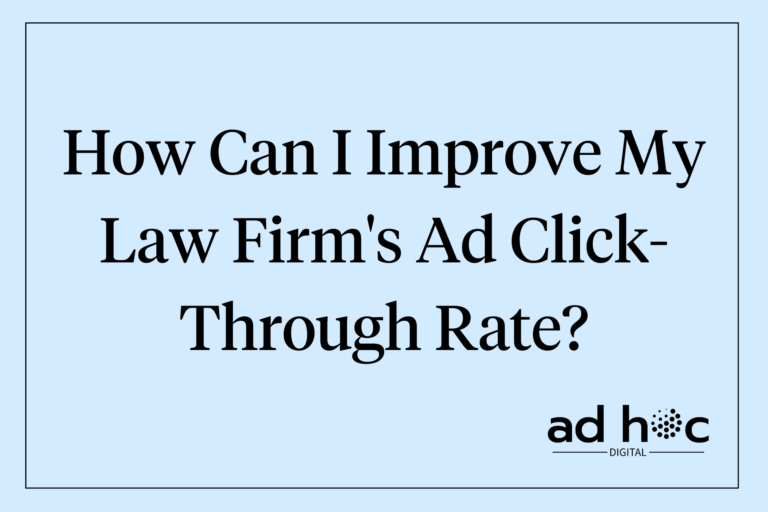What Are Responsive Search Ads and How Can They Benefit My Law Firm?
Responsive search ads (RSAs) are a powerful tool in Google Ads that allow law firms to create flexible and highly relevant ads. By utilizing multiple headlines and descriptions, RSAs adapt to show the most effective combinations to users, enhancing ad performance and increasing efficiency. This detailed guide will explain what responsive search ads are, their benefits, how to create them, and best practices for law firms.
Dive into the fundamentals of crafting effective campaigns by exploring our resources on Google Ads strategies tailored for lawyers.
Understanding Responsive Search Ads
Definition of RSAs
Responsive search ads are a type of ad format in Google Ads that allows advertisers to input multiple headlines and descriptions. Google then automatically tests different combinations to determine which ones perform best for specific searches.
How RSAs Work
RSAs work by dynamically adjusting the headlines and descriptions shown to users based on their search queries and other contextual factors. This flexibility helps create more relevant ads that are likely to achieve better performance.
Difference from Traditional Ads
Traditional expanded text ads (ETAs) have fixed headlines and descriptions. In contrast, RSAs allow for multiple variations, providing greater flexibility and potential for optimization.
For more on the basics of setting up a Google Ads account, visit getting started with Google Ads for lawyers.
Benefits of Using Responsive Search Ads
Increased Ad Flexibility
RSAs allow you to input up to 15 headlines and 4 descriptions, which Google can combine in various ways. This flexibility ensures that your ads remain relevant across a range of search queries.
Enhanced Performance
By testing multiple combinations, RSAs help identify the most effective ad variations. This can lead to higher click-through rates (CTR) and improved ad relevance.
Improved Ad Testing
RSAs automate the A/B testing process by continuously evaluating different headline and description combinations. This automation saves time and provides valuable insights into what works best.
Time Efficiency
Creating RSAs is more efficient than creating multiple static ads. With RSAs, you input your variations once, and Google handles the testing and optimization.
For tips on improving ad performance, visit improving Google Ads CTR for law firms.
Creating Effective Responsive Search Ads
Writing Compelling Headlines
Headlines are crucial for capturing attention. Here are some best practices:
- Include relevant keywords.
- Highlight unique selling points.
- Use a conversational tone.
- Keep headlines within 30 characters.
Crafting Persuasive Descriptions
Descriptions provide more detail and context. Effective descriptions should:
- Include a call to action (e.g., “Call us today for a free consultation”).
- Highlight benefits and features.
- Use a clear and concise language.
- Stay within 90 characters.
Utilizing Ad Strength Indicator
Google provides an ad strength indicator to help you create effective RSAs. Aim for “Excellent” ad strength by following Google’s recommendations and ensuring a diverse set of headlines and descriptions.
Pinning Headlines and Descriptions
If certain headlines or descriptions must appear in specific positions, use the pinning feature. However, use pinning sparingly to maintain the flexibility that makes RSAs effective.
For more on writing compelling ad copy, visit effective Google Ads copy for lawyers.
Best Practices for Law Firms
Targeting Relevant Keywords
Incorporate relevant keywords into your headlines and descriptions to improve ad relevance and quality scores. Use tools like Google Keyword Planner to identify high-performing keywords.
Using Local Keywords
Emphasize geographic relevance by including local keywords in your ads. For example, use “Chicago personal injury lawyer” or “Los Angeles family attorney” to attract local clients.
Highlighting Unique Selling Points
Differentiate your law firm by highlighting unique selling points, such as “Over 20 years of experience” or “Free initial consultation.” These points can persuade potential clients to choose your firm over competitors.
Including Calls to Action
Encourage user engagement by including clear calls to action in your descriptions. Phrases like “Contact us today” or “Schedule your consultation now” can drive conversions.
For more on effective keyword strategies, visit best keywords for law firm Google Ads.
Monitoring and Optimizing RSAs
Tracking Performance Metrics
Regularly analyze key metrics such as CTR, conversion rate, and cost per conversion to evaluate the performance of your RSAs. Use Google Ads and Google Analytics to gain insights into ad performance.
Making Data-Driven Adjustments
Use performance data to make informed adjustments to your RSAs. Optimize your headlines and descriptions based on what works best and continuously refine your ads for better results.
Continuous Testing and Improvement
Keep testing new variations of headlines and descriptions to ensure your ads remain effective. Regularly update and refine your RSAs to stay competitive and improve performance.
For more on tracking and optimizing performance, visit tracking Google Ads performance for lawyers.
Conclusion
Responsive search ads offer significant benefits for law firms looking to optimize their Google Ads campaigns. By leveraging multiple headlines and descriptions, RSAs improve ad relevance, enhance performance, and save time. Following best practices for creating and optimizing RSAs can help your law firm achieve better results and attract more clients.
Additional Resources
- Effective Google Ads campaigns for lawyers
- Improving Google Ads CTR for law firms
- Effective Google Ads copy for lawyers
- Best keywords for law firm Google Ads
- Tracking Google Ads performance for lawyers
- Google Ads for client acquisition law firms
Enjoyed what you read? Subscribe to our newsletter to receive valuable resources weekly. Fill out the form at the bottom of this page if you’re curious about our work, and we’ll reach out to you soon.



